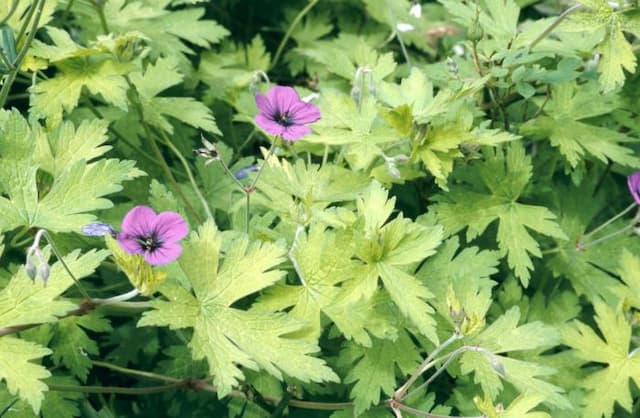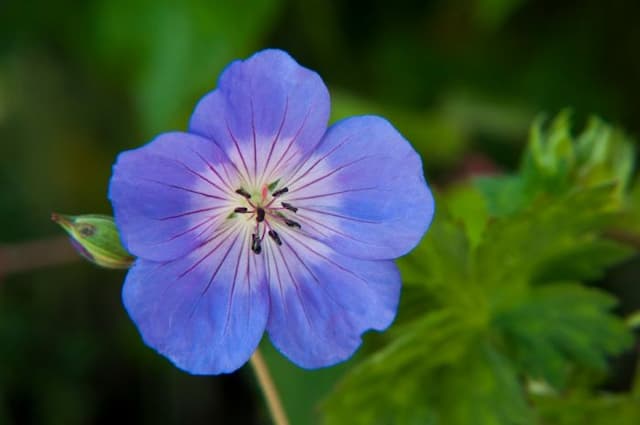Scented Geranium Pelargonium 'Ashfield Monarch' (Z/d)

ABOUT
Pelargonium 'Ashfield Monarch', commonly known as a type of geranium, is known for its beautiful foliage and showy blooms which contribute to its popularity among garden enthusiasts. The leaves of this geranium are notably striking, often featuring a broad, heart or kidney-shaped base and a fine, serrated edge. They are usually lush green and can have a zonal pattern – a zone or band of a darker color – which is typical for many pelargoniums. The flowers of 'Ashfield Monarch' geranium are its most captivating attribute, consisting of clusters of individual blossoms that come together in an umbrella-like formation known as an inflorescence. Each flower may boast an array of rich colors, frequently displaying vibrant shades of pink, purple, or red, and can have distinctive veining or streaks that add to the visual appeal. The petals are rounded and may have a slight ruffle at the edges, giving them a full, opulent look. This geranium variety is favored for its decorative potential, often gracing containers, hanging baskets, and flower beds where its ornamental leaves and profuse flowering can be admired up close.
About this plant
 Names
NamesFamily
Geraniaceae
Synonyms
Ashfield Monarch Geranium, Regal Pelargonium, Martha Washington Geranium
Common names
Pelargonium 'Ashfield Monarch'
 Toxicity
ToxicityTo humans
Geraniums, such as the Pelargonium 'Ashfield Monarch', are generally considered non-toxic to humans. However, ingesting large quantities of the plant could potentially lead to minor digestive upset, such as vomiting or diarrhea, although such cases are rare. It is always advised to exercise caution and keep plants out of reach of young children who might ingest them due to curiosity.
To pets
Geraniums can be toxic to pets, including dogs and cats, if ingested. The most common symptoms of geranium poisoning in pets may include vomiting, anorexia, depression, and dermatitis. In rare cases, ingestion can result in more serious symptoms such as hypovolemia or cardiovascular collapse. Pet owners should be cautious and ensure that these plants are not accessible to their animals to prevent any potential poisoning incidents.
 Characteristics
CharacteristicsLife cycle
Perennials
Foliage type
Deciduous
Color of leaves
Green
Flower color
Pink
Height
2-3 feet (60-90 cm)
Spread
2 feet (60 cm)
Plant type
Herb
Hardiness zones
10
Native area
South Africa
Benefits
 General Benefits
General Benefits- Aesthetic Appeal: Pelargonium 'Ashfield Monarch', commonly known as geranium, adds color and beauty to gardens and indoor spaces with its distinctive and vibrant flowers.
- Easy Maintenance: Geraniums are known for being low-maintenance and can thrive with minimal care, making them suitable for gardeners of all skill levels.
- Drought Tolerance: Geraniums have good drought resistance, requiring less water compared to many other plants, which is beneficial in areas with water restrictions or low rainfall.
- Pest Resistance: These plants are generally resistant to many common garden pests, reducing the need for chemical pesticides.
- Long Blooming Period: Geraniums have a lengthy flowering season, often providing continuous blooms from spring until fall.
- Attracts Pollinators: Geraniums can attract beneficial pollinators like bees and butterflies to the garden, aiding in the pollination of other plants.
- Versatility: Geraniums can be grown in containers, hanging baskets, as well as in garden beds, offering versatility in landscaping and garden design.
- Weather Tolerance: Pelargonium 'Ashfield Monarch' can tolerate a variety of weather conditions, including cooler temperatures, which makes them suitable for different climates.
 Medical Properties
Medical PropertiesThis plant is not used for medical purposes.
 Air-purifying Qualities
Air-purifying QualitiesThis plant is not specifically known for air purifying qualities.
 Other Uses
Other Uses- Potpourri Ingredient: The scented leaves of the geranium can be dried and added to potpourri mixes to give a pleasant fragrance to your home.
- Fabric Infusion: Dried leaves can be placed in cloth bags and tucked into drawers or closets to impart a fresh scent to linens and clothing.
- Natural Dye Source: The flowers and leaves of geraniums can be used to produce natural dyes for fabrics and crafts.
- Culinary Garnish: Edible varieties of geranium can have their flowers used as a decorative and aromatic garnish in culinary presentations.
- Flavoring Agent: The leaves of certain edible geraniums can be used to flavor sugars, teas, desserts, and jellies.
- Artistic Inspiration: Due to their vibrant colors and interesting shapes, geraniums can be used as subjects in painting and photography.
- Companion Planting: Geraniums are sometimes planted alongside other plants to repel pests or attract beneficial insects.
- Religious and Ceremonial Uses: In some cultures, geranium flowers are used in ceremonies and religious offerings.
- Education and Science: Geraniums can be used in educational settings to teach botany and horticulture due to their easy cultivation and propagation.
- Craft Projects: The leaves and flowers of geraniums can be incorporated into paper making, providing texture and color to handmade papers.
Interesting Facts
 Feng Shui
Feng ShuiThe Geranium is not used in Feng Shui practice.
 Zodiac Sign Compitability
Zodiac Sign CompitabilityThe Geranium is not used in astrology practice.
 Plant Symbolism
Plant Symbolism- Resilience - The Pelargonium, commonly known as Geranium, is known to be a resilient plant that can thrive in various conditions, symbolizing an individual's ability to endure and prosper through challenges.
- Comfort - Geraniums are often associated with comfort and familiarity due to their common presence in home gardens and their pleasant scent. They symbolize a sense of solace and domestic tranquility.
- Friendship - With their bright and friendly blooms, Geraniums are sometimes given as gifts between friends, representing a wish for happiness and positive emotions.
- Health - Traditionally, Geraniums have been used for their medicinal properties, such as promoting healing and good health, making them a symbol for wellness and recovery.
- Protection - In some folklore, Geraniums were believed to have protective qualities, warding off negative energies when planted around the home or used in decorations.
 Water
WaterThe common garden geranium should be watered thoroughly when the top inch of the soil feels dry to the touch. During active growth in spring and summer, this may mean watering once every 1-2 weeks, depending on your local climate and indoor conditions. It's best to water deeply, allowing excess water to drain out, which might amount to about half a gallon for a standard 12-inch pot. Reduce watering in the fall and winter to every 2-3 weeks, as the plant enters a period of dormancy. Always avoid letting the geranium sit in waterlogged soil as this can lead to root rot.
 Light
LightGeraniums thrive in bright, indirect sunlight and can tolerate direct morning sun followed by afternoon shade. Place your geranium near a south, east, or west-facing window where it will receive at least 4-6 hours of sunlight each day. Avoid too much direct hot sun in the peak of summer which can scorch the leaves.
 Temperature
TemperatureGeraniums prefer moderate temperatures and will grow best when daytime temperatures are between 65-75°F with cooler nights around 50-60°F. They can survive temperature drops to about 30°F but frost can damage or kill them. The ideal temperature range encourages vibrant blooms and healthy foliage.
 Pruning
PruningPrune geraniums to shape the plant, encourage bushier growth, and remove dead or yellowing leaves and spent blooms. The best time to prune is in late winter or early spring before new growth starts. Regular deadheading of wilted flowers can be done throughout the blooming season to promote continuous flowering.
 Cleaning
CleaningAs needed
 Soil
SoilThe ideal soil mix for geraniums, including the Pelargonium 'Ashfield Monarch', is well-draining and rich in organic matter. A combination of peat moss, perlite, and potting soil can be used to achieve this. The soil pH should be slightly acidic to neutral, ideally between 6.0 and 7.0.
 Repotting
RepottingGeraniums such as the Pelargonium 'Ashfield Monarch' should be repotted every one to two years to refresh the soil and accommodate the growing root system. The best time to repot is in early spring before the onset of the growing season.
 Humidity & Misting
Humidity & MistingGeraniums, including the Pelargonium 'Ashfield Monarch', thrive in average household humidity levels. They do not require high humidity; moderate levels around 40-50% are typically sufficient.
 Suitable locations
Suitable locationsIndoor
Place geraniums near a sunny window and ensure good air circulation.
Outdoor
Plant in fertile soil, full sun, and water when dry.
Hardiness zone
10-11 USDA
 Life cycle
Life cycleThe life of a Geranium 'Ashfield Monarch' (Pelargonium 'Ashfield Monarch') begins with seed germination, which typically occurs in warm and moist soil conditions. Once the seeds germinate, the plant enters the vegetative growth stage, developing roots, stems, and leaves, and it can be encouraged to branch out by pinching the growing tips. Following this, the plant matures and enters the flowering stage, producing vibrant and attractive flowers that attract pollinators, although many pelargoniums are propagated through cuttings rather than grown from seed. After pollination, if it occurs, the plant may produce seeds, completing the reproductive cycle. Finally, in climates where they are not hardy, geraniums either die with the first frost or must be overwintered indoors before beginning a new growth cycle in the spring. Some gardeners may also propagate Geranium 'Ashfield Monarch' through cuttings, which allows for the creation of genetically identical offspring and is a common practice for maintaining desired plant traits.
 Propogation
PropogationPropogation time
Spring-Early Summer
The Pelargonium 'Ashfield Monarch', also known as a type of Geranium, can be propagated effectively through stem cuttings. This popular method is best performed in late spring or early summer when the plant is actively growing. To propagate through cuttings, choose a healthy, non-flowering stem and cut a 4 to 6-inch (approximately 10 to 15 centimeters) section just below a leaf node. Remove the bottom leaves to leave a clean stem, which can then be dipped in rooting hormone to encourage root growth. Plant the cutting in a pot filled with a well-draining soil mix, water it thoroughly, and cover it with a plastic bag to maintain humidity. Place the pot in a warm, bright spot, avoiding direct sunlight, which can lead to scorching. Roots usually develop within a few weeks, after which the plastic can be removed, and the new plant can be gradually acclimated to normal growing conditions.









